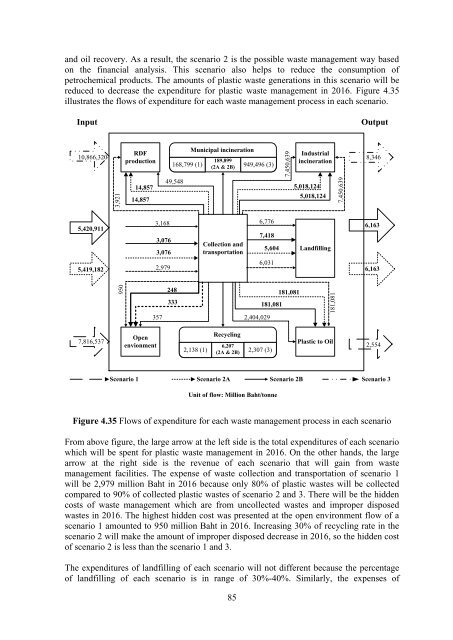Evaluation of Plastic Waste Management in Thailand Using Material ...
Evaluation of Plastic Waste Management in Thailand Using Material ...
Evaluation of Plastic Waste Management in Thailand Using Material ...
Create successful ePaper yourself
Turn your PDF publications into a flip-book with our unique Google optimized e-Paper software.
and oil recovery. As a result, the scenario 2 is the possible waste management way based<br />
on the f<strong>in</strong>ancial analysis. This scenario also helps to reduce the consumption <strong>of</strong><br />
petrochemical products. The amounts <strong>of</strong> plastic waste generations <strong>in</strong> this scenario will be<br />
reduced to decrease the expenditure for plastic waste management <strong>in</strong> 2016. Figure 4.35<br />
illustrates the flows <strong>of</strong> expenditure for each waste management process <strong>in</strong> each scenario.<br />
Input Output<br />
10,866,320<br />
5,420,911<br />
5,419,182<br />
7,816,537<br />
3,921<br />
950<br />
RDF<br />
production<br />
14,857<br />
14,857<br />
Open<br />
envionment<br />
3,168<br />
3,076<br />
3,076<br />
2,979<br />
357<br />
189,899<br />
168,799 (1) (2A & 2B) 949,496 (3)<br />
49,548<br />
248<br />
333<br />
Municipal <strong>in</strong>c<strong>in</strong>eration<br />
Collection and<br />
transportation<br />
Recycl<strong>in</strong>g<br />
85<br />
6,776<br />
7,418<br />
6,031<br />
2,404,029<br />
5,604<br />
181,081<br />
6,207<br />
2,138 (1) (2A & 2B) 2,307 (3)<br />
Unit <strong>of</strong> flow: Million Baht/tonne<br />
7,450,639<br />
181,081<br />
Industrial<br />
<strong>in</strong>c<strong>in</strong>eration<br />
5,018,124<br />
5,018,124<br />
Landfill<strong>in</strong>g<br />
181,081<br />
<strong>Plastic</strong> to Oil<br />
7,450,639<br />
8,346<br />
6,163<br />
6,163<br />
2,554<br />
Scenario 1 Scenario 2A Scenario 2B<br />
Scenario 3<br />
Figure 4.35 Flows <strong>of</strong> expenditure for each waste management process <strong>in</strong> each scenario<br />
From above figure, the large arrow at the left side is the total expenditures <strong>of</strong> each scenario<br />
which will be spent for plastic waste management <strong>in</strong> 2016. On the other hands, the large<br />
arrow at the right side is the revenue <strong>of</strong> each scenario that will ga<strong>in</strong> from waste<br />
management facilities. The expense <strong>of</strong> waste collection and transportation <strong>of</strong> scenario 1<br />
will be 2,979 million Baht <strong>in</strong> 2016 because only 80% <strong>of</strong> plastic wastes will be collected<br />
compared to 90% <strong>of</strong> collected plastic wastes <strong>of</strong> scenario 2 and 3. There will be the hidden<br />
costs <strong>of</strong> waste management which are from uncollected wastes and improper disposed<br />
wastes <strong>in</strong> 2016. The highest hidden cost was presented at the open environment flow <strong>of</strong> a<br />
scenario 1 amounted to 950 million Baht <strong>in</strong> 2016. Increas<strong>in</strong>g 30% <strong>of</strong> recycl<strong>in</strong>g rate <strong>in</strong> the<br />
scenario 2 will make the amount <strong>of</strong> improper disposed decrease <strong>in</strong> 2016, so the hidden cost<br />
<strong>of</strong> scenario 2 is less than the scenario 1 and 3.<br />
The expenditures <strong>of</strong> landfill<strong>in</strong>g <strong>of</strong> each scenario will not different because the percentage<br />
<strong>of</strong> landfill<strong>in</strong>g <strong>of</strong> each scenario is <strong>in</strong> range <strong>of</strong> 30%-40%. Similarly, the expenses <strong>of</strong>

















